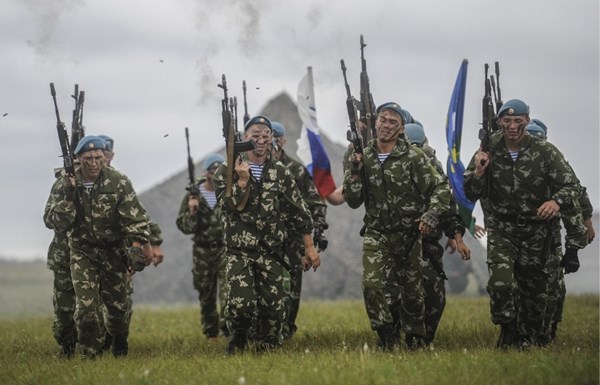Russia launches counteroffensive in Kursk region
Russian forces have launched an offensive in the Kursk region, aiming to lift the blockade on Glushkovsky district, where around 3,000 soldiers are reportedly trapped. With Russia's superior military resources, holding this line presents a formidable challenge for Ukraine. Focus Magazine delves into the unfolding scenarios.
On September 11, Russian forces initiated a counteroffensive in the Kursk region, already executing a large-scale attack. The situation on the left flank for the AFU (Armed Forces of Ukraine) has worsened, notes the DeepState analysis team.
The offensive appears to stem from a directive by Russian President Vladimir Putin to liberate the Kursk region by October 1. This goal is being pursued without reallocating forces from the Pokrovsk and Toretsk directions in the Donetsk region, according to RBC Ukraine.
Currently, Russian units are moving armored vehicles across Seym and smaller rivers. DeepState has recorded Russian armored columns moving from Korenevo to Snagost, with active fighting occurring in the latter village.
Western military expert Rob Lee reports that an eight-tank convoy from the 51st VDV Regiment has reached Snagost via the road from Korenevo . Despite Ukrainian strikes on river bridges, the convoy remains intact.
Russian military bloggers are claiming the alleged liberation of Snagost, Viktorovka, Gordeevo, Obukhovka, Vnezapnoye, Byakhovo, and Apanasovka. Commander of the special unit "Akhmat", Apti Alaudinov, has claimed that approximately ten settlements in the region have been retaken by the Russian troops. Following this, the Russian forces plan to target Lyubimovka and Zelyonyi Shlyakh to cut off Ukrainian troops in northern Kursk region.
Mash, a channel connected with Russian security services, reports a 150-square-kilometer advance by Russian troops in the area. The engagement involves marines from the 155th and 810th brigades and the 56th VDV regiment.
Ukrainian military-political observer Alexander Kovalenko of the "Information Resistance" group says the Russian command has bolstered their forces in the Kursk region to over 35,000 troops to displace Ukrainian units.
Russian forces are focusing on four key fronts:
- Apanasovka–Snagost: Unblocking Glushkovsky district and regaining control over the "Koreneyo-Troitskoy" road.
- Zhuravli–Kalinov: Controlling logistics along "Koreneyo-Safonovka" for simplified northern front logistics.
- Pogrebki: Advancing towards the "Lgov-Sudha" road and Sudha from the north.
- Borki: Sealing the southeastern sector of AFU control along the Psel River.
Kovalenko notes that the Russian counteroffensive involves ten combat units, including the twice-reformed 155th Marine Brigade. The 22nd "BARS" unit has also been relocated to the area from Pavlovka, Donetsk region.
Although the Ukrainian Forces are relying on fortifications built by Russian forces, facilitating active defense, the coming days will show the outcome of this counteroffensive, sums up Kovalenko.
Military analyst Yan Matveev believes the current phase aims at deblocking the Glushkovsky district. Russia has been fortifying pontoon crossings and defending remaining passages, with Bild reporting on August 20, 2024, that Ukrainian troops were only 5 kilometers from sealing the "cauldron".
The choice of Glushkovsky is also strategic, distancing it from the main supply route via Sudzha, heavily patrolled by AFU. An attack here risked cutting off the entire Kursk direction from logistics.
Military expert Dmitry Snegiryov corroborates this strategy, noting that deblockading the Glushkovsky units, consisting of up to 3,000 soldiers, is the current priority for Russia.
"As of now, while Russian troops have seen tactical success, they have not broken AFU 's positions. This limited success pushed their command into launching a counteroffensive. It's early to gauge its overall success," Snegiryov told Focus.
The Kursk region hosts some of the best-trained AFU assault units, which have forced the Russians into mobile warfare and built a layered defense system. Two lines of Russian fortifications were also seized during the Kursk advance.
"This active defense will lean on existing Russian engineering structures, easing our efforts," Snegiryov asserted.
Military analyst Ivan Stupak of the Ukrainian Institute for the Future says the operation has a two-week timespan, with three AFU action plans in duty:
- Defend all Kursk holdings.
- Withdraw to defensible positions.
- Redeploy back into Ukraine.
"Efficiency and understanding one's limits are critical. Like knowing when it's time to leave a party before being asked to go," the analyst concluded.
Ukraine's President Volodymyr Zelensky mentioned relocation of up to 60,000 Russian soldiers from Zaporizhzhia and Kherson. The Wall Street Journal highlighted that approximately 11,000 Ukrainian troops are involved in this operation.
